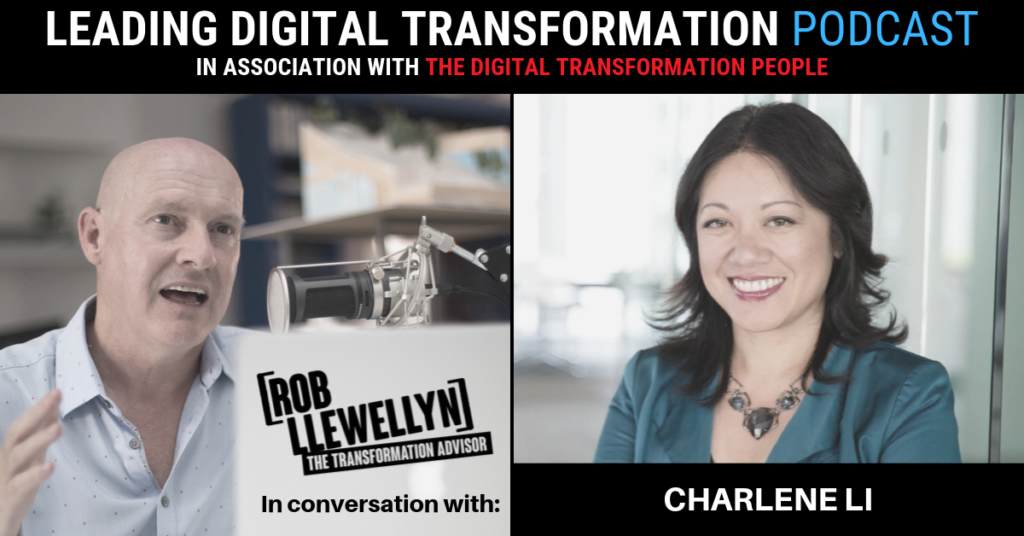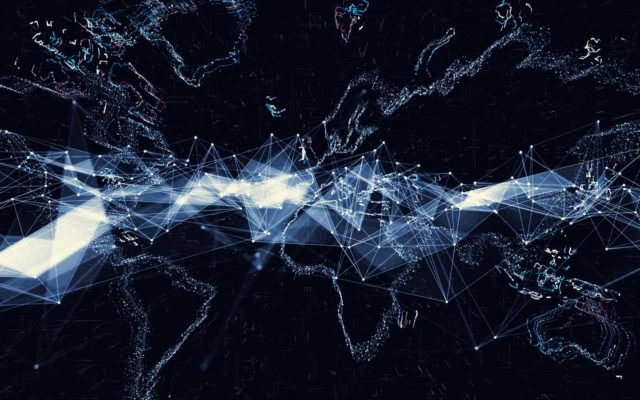‘Leading Digital Transformation’ is a weekly podcast series produced in collaboration between The Digital Transformation People and Rob Llewellyn digital transformation advisor and founder of CXO Transform.
During this series, Rob interviews experienced practitioners, authors and thought leaders whose stories and experiences provide valuable insights for digital transformation success.

In this episode, Rob is joined by Charlene Li, author and Founder of Altimeter the leading research and advisory business that helps leaders leverage disruptive technologies and thrive as both business and society learn to navigate seismic change. Her views are frequently sought by leading media channels such as The Wall Street Journal, New York Times, USA Today, Reuters, and The Associated Press. She has appeared on 60 Minutes, The McNeil NewsHour, ABC News, CNN, and CNBC. Charlene has written or co-authored five books, including “Groundswell: Winning In A World Transformed By Social Technologies”, the New York Times’ bestseller, “Open Leadership”, “The Engaged Leader” and her latest book “The Disruption Mindset” which was published in September 2019.
“The hardest part if you’re a successful company, is that you have beautiful, profitable customers looking you in the face, saying, “come on, let’s do business together” And to be disruptive, you then have to say to them, “love you, and I’ll serve you really well, but my future lies elsewhere” and you’re going to turn part of your attention to that future as well.”
Listen here and read the full transcript below.
Transcript
Rob Llewellyn [00:00:22] For the past two decades, Charlene Li has been helping people see the future. She is the author of five books, including The New York Times bestseller “Open Leadership” and is the co-author of the critically acclaimed book “Groundswell”. She’s the founder and senior fellow at Altimeter, an analyst firm that was acquired in 2015 by Profit. Named by Fast Company as one of the most creative people in business, Charlene is an expert on digital transformation. But Charlene isn’t here today to talk about digital transformation. She is here today to talk about disruption. She believes we all need to stop talking about disruption and start doing it. She’s even gonna give us some ways to make disruption a part of our agenda every single day. So let’s jump into the interview with Charlene. Charlene, it’s great to have you here. Welcome.
Charlene Li [00:01:17] Thanks for having me.
Rob Llewellyn [00:01:19] Charlene, let’s kick off with a very fundamental question. What is disruption and how is it similar or different from innovation or digital transformation?
Charlene Li [00:01:31] Well, I feel like I’ve been dealing with disruption my entire career. So what is disruption? Well, it’s something that throws you off your kilter and it changes the way that your standing is in the world and your relationship to your organisation, to the people around it, even to your customers. And when it comes to innovation and digital transformation, what you’re really trying to do is to disrupt the status quo. And it is especially important in digital transformation because you’re trying to transform your organisation from what it is today to what it could be to harness all those opportunities. And the biggest challenge I find with people going through a digital transformation is they want it to be not disruptive. And then the reality is, and my research is that, when you’re going through a transformation, it is by its nature going to be hard. And when I look at why some organisations succeed and don’t succeed at digital transformation, the ones who do are the ones who really embrace the idea that this is going to be a disruptive process.
Rob Llewellyn [00:02:32] I mean, Charlene, one of the ways that I see it is that you know, if a company is not being disruptive, they’re almost -, the alternative is really almost similar to being on the back foot, on the defensive, trying to stem the bleed and protect themselves from the disruption that’s happening outside. So, the alternative from disruption is not a very good one, is it?
Charlene Li [00:02:52] No, it isn’t. I like to think about are you going to be a victor and thrive with disruption or you’re going to be a victim of it? And I don’t think anybody wants to raise their hand and say, “okay, I’ll be a victim. I’m gonna be sitting here being in a defensive posture”. But it is so hard. I mean, I really empathize with so many organisations that say “I know what I need to do, but it looks like it’s going to be incredibly difficult”. “How do I move this organisation in the direction?” And when I talk to leaders of digital transformation and these people who see the need for disruption, they’re incredibly frustrated, because they can see the opportunity and it feels like no one else can see it or you’re so afraid of what the change might be, that they’re just frozen in place.
Rob Llewellyn [00:03:43] So with that in mind, there are so many people talking about the need for organisations to be disruptive. And it’s all very well for us all to talk about it. But how should companies approach disruption?
Charlene Li [00:03:56] Well, I did some research on this, because I didn’t know what the right answer was. And what I found is that these disruptive organisations, companies who have been able to drive exponential growth in change, they do one thing and one thing really, really well. And that is they focus on their future customer. And it sounds so simple. But really, ask yourself, do you know who your future customer is? Because if you don’t, then you won’t make the sacrifices, the investments, make the hard choices today to go after them in the future. And that’s the hardest part because if you’re a successful company, you have beautiful, profitable customers looking you in the face, saying, “come on, let’s do business together”. And to be disruptive, you have to say to them, “love you, I’ll serve you really well, but my future lies elsewhere” and you’re going to turn part of your attention to that future as well. So these disruptive organisations do a really good job of managing both the present and also investing in the future, making those tough, tough choices today.
Rob Llewellyn [00:05:01] Now, some of these organisations, Charlene, I mean, they range in size, of course, from small businesses to multinationals with hundreds of thousands of people. And these are enormous workforces with lots of energy and innovative talent. But if the leadership isn’t behind the ambition to transform, disrupt, well, things aren’t gonna go very far. So how does leadership differ in a disruption strategy?
Charlene Li [00:05:29] It’s significantly different because they realise that to keep the organisation focussed on that future, he’d keep them aligned on what this purpose is. They have to be thinking about it as starting a movement. And most leaders don’t sign up and say, “yeah, I’m looking for that promotion to lead a movement”. So, it’s a very different type of mindset. And the reason why movements are so important is that you’re asking people to go on a really tough journey, a transformation, a disruption. It’s going to be hard. So tell them, be very honest about it upfront. “This is going to be hard”. And a movement is really powerful because it allows other leaders to step up, to put on that mantle of leadership and become leaders themselves. They become part of the movement and movements can be steered, they can take on a life of their own. And it’s important to feel like you’re part of that. When I do my advisory, I walk around an organisation and I ask people, so you know, give me one hour, “I’ll be right back” I say to the leadership, and I go around and I ask people, “So what do you think your strategy is? Can you tell me who your future customer is? Can you tell me what you’re doing every day helps you achieve those strategic objectives?” And I can come back and say in most cases to the leaders, “Nobody knows what your strategy is. They don’t know how they fit into this. They don’t know who your future customer is. There are some basic alignment issues here around being really consistent and making sure that everybody in the organisation knows where you’re heading”. And I find that leaders tend to think that if they say it once then everyone’s heard it. And the reality is, you have to say it over and over again as if you are trying to drive that movement.
Rob Llewellyn [00:07:10] Now a lot of these leaders, Charlene, they’ve been in their positions for many, many years and they are where they are because of the experience that they have in running these organisations, some of which are very large. Now disruption hasn’t been something that these leaders have had to deal with in years gone by. So what can they do to come to terms with the need to think in a disruptive way, nowadays?
Charlene Li [00:07:38] Yeah, and I think if an organisation is used to doing things in a status quo way, they realise that this is probably not going to sustain it. They know they have to change. But what they really want is the change to happen without it being disruptive or hard. I’m happy to change, but it has to be this narrow bandwidth of what I can tolerate, what I think my organisation can tolerate. And when a leader and goes “no, I think there’s a great opportunity here. Are you with me?” That part, “are you with me?” is the crucial part that many leaders don’t necessarily make sure that people are on. Because if people are not bought into this vision of the future customer, this vision of where the opportunity is, then they ask themselves, “why am I making all the sacrifice?”. It’s not worth it, especially if it’s not known throughout the entire organisation. That’s why knowing who your future customer is is so crucial and such a linchpin to your strategy. The leadership then needs to make sure that inside a really large organisation, people are aligned on this. I can tell you, I’ve gone into these large organisations and I go, tell me who your customer is and nobody’s agreed on even who their current customer is, let alone who the future customer is. If you’re not aligned with having a clear idea of what you’re trying to accomplish, you can’t get there. So again, we’ve seen this in digital transformations, there are 18 different customer journeys depending on where you’re looking at and different versions of who the persona is. And that’s all really good work but can we get together and align on one picture, one vision for what we’re trying to accomplish, and that is the purpose of leadership, to make sure there is that alignment.
Rob Llewellyn [00:09:27] And of course, one of the responsibilities of leaders is to nurture that culture, which is so important. And culture, as we know, is often the reason why digital transformation fails. So how are the cultures of disruptive organisations different?
Charlene Li [00:09:44] Well, one of the things they do really well is they understand that culture, first of all, is really important to their strategy. They live by that Peter Drucker quote “Culture eats strategies for breakfast every day”. And so they have this really clear strategy of where trying to go after this future customer and intentionally, actively, align their culture around that future customer. And they do this around three major beliefs that I think really distinguish what a disruptive organisation does. And this allows them to feel comfortable and thrive with change and flux and disruption, and they’re just much better at it. And it’s the three beliefs, are there a sense of openness, that information and decision making is much more in the openness, transparency. And it creates trust and accountability, so that you can go a lot faster. There’s a strong sense of agency inside of the people in the organisation. This is very different than empowerment, because empowerment says “I’m waiting for someone to give me power”. Agency says “I already have it and I can use it to accomplish things”. And the third belief is a strong bias for action. And you’re not going to stand still, you can’t stand to stand still. So as long as you have minimally viable data and information, as I like to call it, you’re going to make a decision versus trying to find the perfect answer. Those three beliefs are then ingrained in the culture operating system of the organisation. They make sure that the processes, the organisational structure, the rituals, the symbols are all aligned to make sure that these beliefs go throughout the entire organisation. So I think culture is one of those things where people kind of think you can’t really change, but these disruptive organisations actively believe you have to develop it by looking at these beliefs and then making sure that the behaviours behind them are aligned against those beliefs.
Rob Llewellyn [00:11:42] And as you just pointed out, Charlene, there’s a lot of resistance to the idea that you can’t change your culture. But the reality is, cultures need to change for these organisations to be successful. Now, you’ve just talked about three beliefs. In an organisation which has been running for maybe fifty, sixty years or more, how long does it actually take to change a culture?
Charlene Li [00:12:05] I talked to one organisation where they had this one value of the organisation called Respect. And one of the things over time is that the idea of respect where anybody can have respect for all sorts of different opinions. They had morphed into respecting “don’t disagree with people”. So you had to have respect for everybody. And so people did not feel comfortable speaking up. So they intentionally went back to this value, went back to the archives of what the founder had said. This is what respect means and reinvigorated that within the organisation. And within six months, a short amount of time, they had changed the behaviours and the beliefs and how they talked about that, actively saying to people, we want you to speak up so that way we can be respectful to you. Respect does not mean you shut up, in fact, it’s just the opposite. We want you to speak up. And they acknowledge that they had drifted away from this original intent, but they actively went after this because they said: “This is one of the most fundamental beliefs in the organisation that’s holding us back”. So an exercise and encourage people to do is simple. Take some Post-It notes with your team (it doesn’t have to be an executive team, but anyone in your team) and write down on the Post-It notes all the beliefs that you think are holding you back. Put them on the wall, put them together and agree with yourselves that we’re not going to believe those things anymore. We’re not going to say those things, we’re not going to have the behaviours that support those beliefs, we’re leaving those behind as we do not believe in them. And then you take Post-It notes and put on a different wall the beliefs that are going to move us forward. What are those beliefs going to be? And it’s so important to do the second part because you can’t just say we’ve got to stop doing things and believing things. What will you believe in? That takes a little more time and more effort. But then you identify what those are. Agree as a team that you’re going to do those things and identify the behaviours that are going to support those beliefs, behaviours that you as a leader are going to have to exemplify. And what I find is when organisations do this, they can change their culture literally overnight, because you as a team, as a leadership team, have decided we’re going to believe and think and work in a different way. We’re going to intentionally create the culture that we want.
Rob Llewellyn [00:14:22] Now, Charlene, you’re in and out of a lot of organisations conducting research. Tell us, what are some of the surprises you’ve found in that?
Charlene Li [00:14:33] I found two surprises, actually. The first one is when I talked to leaders – one of the things I did was I talked to a thousand leaders. I surveyed them all around the world and found that there were two things that drove their disruptive leadership capabilities: an openness to change mindset, but also the leadership behaviours that empowered and inspired people to take action. And what I found really surprising is that men and women could have the exact same capabilities around those two things. And yet women would rate themselves as significantly less able to drive disruptive transformation. And I found that fascinating, and especially this was the case in the United States, less so than in other countries like the UK, Germany, Brazil and China. It was really distinct in the United States. And I find that fascinating because given how much change needs to happen in the world, we have a segment of the population that doesn’t feel as competent and capable of doing this, even though they have all the skills that allow them to be successful at it. So there was a distinct gender gap in terms of disruptive leadership. The second thing that I found is that these disruptive organisations were actually incredibly well-organized and well run. We think that disruptive organisations live in a constant state of chaos and flux. And it was just the opposite. They had strong process. We often think process is like the worst thing that could happen for innovation and disruption; it’s actually really well done inside of disruptive organisations because when everything is locked down, everyone knows how things work. They can then put all of their energy into creating that disruptive change. So it was fascinating to see how strong process was and how well-aligned people were against using process and organisation and especially all the rituals and symbols that flowed throughout the organisation to reinforce all of that.
Rob Llewellyn [00:16:32] Charlene, we often hear about the new start-ups, not necessarily new, but of course, disruptive start-ups, which are disrupting different industries. But these large and established incumbent organisations, they have a considerable advantage in terms of resources that they have available to them. How much do you think they’re actually tapping into these resources and to these advantages that they have over these start-ups?
Charlene Li [00:17:01] You know, it’s so interesting because incumbents think that they’re on the back foot again as we started this conversation. In fact, they have the biggest advantages. And a couple of them are – first of all, they have customers. You don’t have to go and find customers. They have cash. They have people, they have brand. They have the ability to scale quickly. Start-ups have none of those things. The difference is that incumbent large organisations also have this one curse. It’s called profitable customers and start-ups don’t have to worry about an installed base. They can just go after the future customers. So I think the big difference though today is why couldn’t organisations have done this in the past? Clay Christensen wrote a fantastic book, “The Innovator’s Dilemma”. That was 20 years ago. And every degree 20 years ago, incumbents didn’t have much of a chance. But the difference today is that we are able to exchange information flows, be able to have and manage very large, complex organisations in a much more streamlined way because of technology, all these collaboration platforms, just even simple things like email to be able to communicate much faster, allow us to be able to find that future customer, identify who they are, and then be able to serve them really well. The large organisations talk to their future customers every day. They just may not realise it. So when you can enable and the person at the front lines has the agency to say, hey, I found a future customer because I know what one looks like. I have one here. Let’s go take a very close look at who this person is and better understand them and be able to serve them better in the future. That’s what the big advantages of an organisation is. If they could get out of the way and be able to focus on that, make sure that that front line person’s voice is heard inside the organisation, instead of being filtered through multiple levels. That’s a huge advantage that large organisations have.
Rob Llewellyn [00:19:07] Your latest book, Charlene is “The Disruption Mindset”. Tell us, what are you hoping to accomplish with that book?
Charlene Li [00:19:14] Well, I wanted to help people understand that we’ve been thinking about disruption backwards, that we keep looking for some technology or innovation to drive growth, that disruption will drive growth. But it’s actually growth that creates disruption. Growth is really hard. So how do we think about growing in an exponential way and embrace it, not be afraid of it? And what I really want to accomplish with this book is to create a movement in of itself, to connect all of these disruptors in the world, help them see that they could become that person of change to drive that disruption themselves and to drive that creation and exponential growth not only in their organisations, but also in our communities and even in the larger society, primarily because we have so many problems in this world that need to be solved. Why go after the small ones? Let’s go create some really big change, really big impact. And I’m hoping with this book to inspire more people to become disruptors themselves.
Rob Llewellyn [00:20:16] So there’s a lot that you’ve packed into this book, Charlene. But if there was one big takeaway, aside from what you’ve just told us, if there was one big takeaway that you’d want people to get from that book, what would it be?
Charlene Li [00:20:29] It would be to start thinking in a disruptive way. And if you’re going to go and create change as a leader. And frankly, if you’re not creating change, you’re not a leader. You’re a manager. And I think there’s so many people who want to see and be leaders, then think about really how can you drive a huge amount of change because you’re quite capable of doing it. Your organisation is capable of doing this too, as well. And don’t stop short. Disruption is completely within our grasp. So let’s go and get it.
Rob Llewellyn [00:21:00] So Charlene, people can go out and get a copy of your book, “The Disruption Mindset“. But where else can people go to learn more about these kind of thoughts that you’ve been sharing with us today?
Charlene Li [00:21:10] You can find me on my website, www.CharleneLi.com, just my name. And I’m also on all the various social media platforms under my name as well. And I look forward to connecting with people.
Rob Llewellyn [00:21:21] Charlene, thank you so much. It’s been a real pleasure speaking with you.
Charlene Li [00:21:24] Thank you for having me.
Announcer: [00:21:24] We hope you enjoyed this episode of “Leading Digital Transformation” with Rob Llewellyn and The Digital Transformation People. Visit www.thedigitaltransformationpeople.com to secure the knowledge, talent and services you need for digital transformation success. To continue your journey as a certified transformation professional, visit www.RobLlewellyn.com. Be sure to subscribe to the podcast and follow us on Twitter @TheDigitalTP and @RobertLlewellyn
Article by channel:
Everything you need to know about Digital Transformation
The best articles, news and events direct to your inbox
Read more articles tagged: Digital Disruption, Featured






